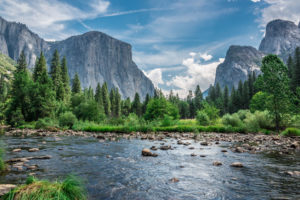Trump Proposes Increased Entrance Fee for 17 National Parks
 Yosemite National Park, one of the seventeen parks that would be subject to the potential price increase.
Yosemite National Park, one of the seventeen parks that would be subject to the potential price increase. Throughout his presidency, Trump has talked about creating policies and laws that would support small businesses, protect American jobs, and strengthen and grow the middle class. Yet, we all know that actions speak louder than words. Trump is no stranger to proposing plans, such as tax cuts, that will ultimately only benefit the wealthiest of Americans and harm the middle class and the poor. And so it was no surprise last week when Trump and the US Department of the Interior proposed a substantial increase in entrance fees at seventeen of the most popular national parks during peak visitation season. If implemented, the entrance fee for the aforementioned parks would more than double from $25 or $30 per vehicle to $70 per vehicle. The National Park Service says these increased fees would “generate badly needed revenue for improvements to the aging infrastructure of national parks,” but park visitors aren’t convinced. Many individuals and organizations that support national parks are concerned about the negative effects such sharp increases would cause to park patrons.
For someone who has a net worth of $3.1 billion USD (cough, cough Trump), a $40 or $45 increase to enter a national park is virtually nothing. However, for many Americans this increase would be cost prohibitive; it would effectively price-out the majority of low-income families. “Americans already own these parks and they shouldn’t have to empty their wallets to enjoy them,” Democratic Senator Jon Tester of Montana told the Flathead Beacon. “Glacier and Yellowstone should be accessible to all of us.” It is not just American families that will be impacted by the restructured fee. The local communities and businesses that surround and depend on the national parks will also feel the effects. Earlier this year, Headwaters Economics, an independent, nonprofit research group, published a “National Parks Economic Impact” study which estimates visits, jobs, and labor income created by visitor spending in National Park Service lands. Overall, the study found that commerce from National Park Services’ visitors “generates and supports a considerable amount of economic activity within park gateway communities.” It is a simple equation. If families can no longer enter the national parks, then they will not be traveling to the gateway communities and spending money. When tourism spending decreases in an area, the local economy is becomes under-stimulated and jobs are lost.
Doubling the entrance fees is certainly not the most effective or fair way to address the nearly $12 billion backlog of deferred maintenance of the National Parks. Americans are frustrated because the responsibility to pay for overdue projects should fall on the government, not on park visitors. Trump’s proposed 2018 budget seeks to cut the National Park Service budget of $296.6 million with the loss of 1,242 jobs. Opponents are taking their concerns directly to Interior Secretary Ryan Zinke. “Secretary Zinke would rather take money directly out of the pockets of hardworking Americans instead of coming up with a serious budget proposal for the National Park System,” said Rep. Raúl Grijalva (D-AZ), the ranking member of the House Natural Resources Committee. A similar sentiment was shared by Senator Maria Cantwell (D-WA) who said, “While Secretary Zinke flies around on private jets using our taxpayer dollars, he is hiking up the fees all American families pay to enjoy our National Parks.”
We as humanists need to take action and let Trump and Zinke know that we do not support this proposed increase. Go here and make your voice heard by submitting a comment until November 23, 2017. A final decision by Zinke is expected to be announced later this year.
